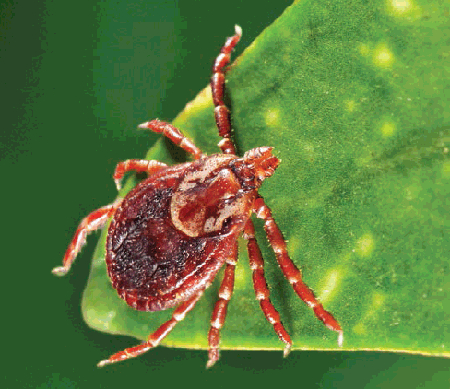Caused by infection with the obligately intracellular aerobic bacterium Rickettsia rickettsii. Ticks are both natural reservoirs of this organism and vectors to infect humans.[1]Biggs HM, Behravesh CB, Bradley KK, et al. Diagnosis and management of tickborne rickettsial diseases: Rocky Mountain spotted fever and other spotted fever group rickettsioses, ehrlichioses, and anaplasmosis - United States. MMWR Recomm Rep. 2016;65:1-44.
http://www.cdc.gov/mmwr/volumes/65/rr/rr6502a1.htm
http://www.ncbi.nlm.nih.gov/pubmed/27172113?tool=bestpractice.com
The predominant vector in the eastern, central, and western US is the dog tick Dermacentor variabilis. In the northern Rocky Mountains most cases are transmitted by the wood tick Dermacentor andersoni. The brown dog tick Rhipicephalus sanguineus was identified as a vector along the US-Mexico border in 2003 and is now the most common vector in southwestern US and Mexico.[1]Biggs HM, Behravesh CB, Bradley KK, et al. Diagnosis and management of tickborne rickettsial diseases: Rocky Mountain spotted fever and other spotted fever group rickettsioses, ehrlichioses, and anaplasmosis - United States. MMWR Recomm Rep. 2016;65:1-44.
http://www.cdc.gov/mmwr/volumes/65/rr/rr6502a1.htm
http://www.ncbi.nlm.nih.gov/pubmed/27172113?tool=bestpractice.com
[6]Arizona Department of Health Services. Arizona Rocky Mountain spotted fever handbook. Feb 2020 [internet publication].
https://www.azdhs.gov/preparedness/epidemiology-disease-control/rocky-mountain-spotted-fever/index.php#additional-resources
[9]Bestul N, Padilla R, Montaño T, et al. Knowledge, attitudes, and practices on Rocky Mountain spotted fever among physicians in a highly endemic region-Mexicali, Mexico. Am J Trop Med Hyg. 2022 Oct 12;107(4):773-9.
https://www.ncbi.nlm.nih.gov/pmc/articles/PMC9651539
http://www.ncbi.nlm.nih.gov/pubmed/35995132?tool=bestpractice.com
[12]Demma LJ, Traeger MS, Nicholson WL, et al. Rocky Mountain spotted fever from an unexpected tick vector in Arizona. N Engl J Med. 2005 Aug 11;353(6):587-94.
http://www.nejm.org/doi/full/10.1056/NEJMoa050043#t-article
http://www.ncbi.nlm.nih.gov/pubmed/16093467?tool=bestpractice.com
Tick species in the genus Amblyommaare the causative vector in Central and South America.[1]Biggs HM, Behravesh CB, Bradley KK, et al. Diagnosis and management of tickborne rickettsial diseases: Rocky Mountain spotted fever and other spotted fever group rickettsioses, ehrlichioses, and anaplasmosis - United States. MMWR Recomm Rep. 2016;65:1-44.
http://www.cdc.gov/mmwr/volumes/65/rr/rr6502a1.htm
http://www.ncbi.nlm.nih.gov/pubmed/27172113?tool=bestpractice.com
[8]Galvâo MA, Dumler JS, Mafra CL, et al. Fatal spotted fever rickettsiosis, Minas Gerais, Brazil. Emerg Infect Dis. 2003 Nov;9(11):1402-5.
http://wwwnc.cdc.gov/eid/article/9/11/03-0193_article
http://www.ncbi.nlm.nih.gov/pubmed/14718082?tool=bestpractice.com
Centers for Disease Control and Prevention: tick ID
Opens in new window
Transmission via blood transfusion is extremely rare.[1]Biggs HM, Behravesh CB, Bradley KK, et al. Diagnosis and management of tickborne rickettsial diseases: Rocky Mountain spotted fever and other spotted fever group rickettsioses, ehrlichioses, and anaplasmosis - United States. MMWR Recomm Rep. 2016;65:1-44.
http://www.cdc.gov/mmwr/volumes/65/rr/rr6502a1.htm
http://www.ncbi.nlm.nih.gov/pubmed/27172113?tool=bestpractice.com
[Figure caption and citation for the preceding image starts]: Dorsal view of a female American dog tick Dermacentor variabilisCenters for Disease Control and Prevention [Citation ends].
